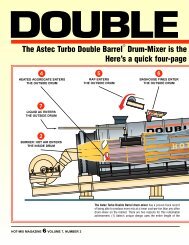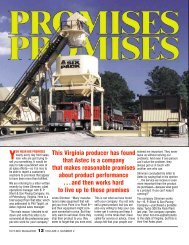Create successful ePaper yourself
Turn your PDF publications into a flip-book with our unique Google optimized e-Paper software.
(Continued from Page 7)<br />
keep 8 million gallons of liquid<br />
AC at a temperature that was uniformly<br />
manageable. This was not<br />
Sargeant Marine’s first time to be<br />
associated with Heatec.<br />
“We’ve done business with Heatec<br />
for years,” said Stow. “We have<br />
purchased more than 100 liquid-<br />
AC shipping containers from<br />
Heatec and our association has<br />
always been very satisfactory.<br />
There’s a lot of mutual trust there.<br />
We hold them in very high regard.<br />
“But we still shopped this project<br />
around. We met with three different<br />
suppliers and asked all of<br />
them to put packages together<br />
and give us bids. And after some<br />
more pretty intense meetings, we<br />
selected Heatec to do the job.”<br />
How Heatec designed<br />
the thermal-liquid system:<br />
The “job” was more complex<br />
than it might appear on the surface.<br />
There were 14 different containers<br />
built into the cargo hold of<br />
the ship. Each had to be outfitted<br />
with serpentine heating coils at<br />
two levels: high and low. Three<br />
hot-oil heaters had to be installed<br />
on the deck of the ship. Pumps<br />
and control valves had to be<br />
strategically placed to provide an<br />
even supply of hot oil to the coils.<br />
According to Buddy Ledford, the<br />
director of engineering for Heatec,<br />
his company was probably the<br />
only one in the country that could<br />
handle the total job. “We are able<br />
to do something that is pretty<br />
unusual in our industry. We can<br />
provide all of the heating coils, as<br />
well as the heating source. A lot<br />
of companies that make thermalfluid<br />
heaters do not make heating<br />
coils—and those that make coils<br />
do not typically make heaters. We<br />
can handle it all: heaters and<br />
coils. On this job, it was definitely<br />
to the customer’s advantage to<br />
have one company that was<br />
capable of providing both types<br />
of components.”<br />
Ledford said that the three Heatec<br />
heaters were installed on the main<br />
deck of the ship. The large structure<br />
that houses the heaters is<br />
clearly visible in aerial photos on<br />
the aft part of the ship, just behind<br />
the stack and the bridge.<br />
“Each of the heaters is rated at 15<br />
million Btu,” said Ledford. “Each<br />
unit has two circulating pumps,<br />
one of which is a standby in case<br />
the other fails. All three of the<br />
heaters feed into a common<br />
header that goes from one end of<br />
the ship to the other. There is a<br />
minimum bypass valve located in<br />
the bow of the ship. Regardless<br />
of how many of the 14 cargo<br />
compartments are being heated,<br />
if they have a heater turned on,<br />
there is a flow measurement taken<br />
for that heater. That reading<br />
goes into a summing controller<br />
which controls a minimum<br />
bypass valve—and this assures<br />
that each heater maintains an<br />
absolute minimum flow rate. It’s<br />
a pretty complex system—but<br />
the heating requirements on this<br />
job were also pretty complex.”<br />
According to Ledford, the system<br />
requires a total of 45,000 gal.<br />
(170 000 L) of heating oil. “That<br />
includes the oil required in the<br />
heater, the headers, and all of the<br />
heating coils. Each heater has a<br />
minimum flow rate of about 600<br />
gpm (2 300 Lpm). When all three<br />
pumps are working, the flow rate<br />
is about 2,100 gpm (8 000 Lpm).”<br />
A total of 22 miles<br />
of serpentine heating coils<br />
Ledford said that the heating system<br />
uses about 22 miles of the<br />
serpentine heating coils in the 14<br />
separate cargo compartments.<br />
“We fabricated all of the coils,”<br />
said Ledford, “and the shipyard<br />
did the actual installation. Imagine:<br />
22 miles of heating coils.”<br />
The actual heating process itself<br />
is fairly complicated. In a typical<br />
cargo compartment or tank, there<br />
are two levels of heating coils:<br />
one at the bottom of the tank and<br />
another about 5 ft. (1.5 m) higher.<br />
The low coils do not have a very<br />
high heating capacity because<br />
In drydock during its conversion and refitting, the Asphalt Commander towered<br />
over the workers. In this photo, the ship is far in the background (notice<br />
the size of the forklift by the bow) behind Heatec employees Ron Henry (left)<br />
and Gary Yearwood (right) who were installing the on-board heaters.<br />
they are only intended to replace<br />
whatever heat loss there is<br />
between the ship’s hull and the<br />
water. The higher sets of coils do<br />
most of the actual work of heating<br />
the liquid AC in the tanks.<br />
Once the liquid AC at the bottom<br />
of the compartment gets hot<br />
enough, it will move up toward<br />
the surface. Eventually, the liquid<br />
AC will actually roll over and start<br />
a circulating motion that keeps<br />
the contents of the compartment<br />
at an even temperature.<br />
The actual work of refitting the<br />
ship took a little more than seven<br />
months, although the entire project<br />
took about a year as far as<br />
Sargeant Marine was concerned.<br />
“We spent a fair amount of time<br />
finding the ship and purchasing<br />
it,” said Stow. “It was in the<br />
Maritime Administration reserve<br />
fleet, excess to the needs of the<br />
government. It was a product<br />
tanker—originally named the<br />
Falcon Champion—and it was a<br />
resupply vessel for U.S. Navy<br />
tankers. We bought the ship and<br />
towed it to Mobile, Alabama for<br />
conversion and refitting.”<br />
And how did things go after the<br />
ship was refitted and renamed<br />
the Asphalt Commander?<br />
“We had the normal gremlins<br />
you’d expect on the first voyage,”<br />
said Stow. “But the second voyage<br />
was really outstanding! Everyone<br />
who has dealt with the Asphalt<br />
Commander so far has been very<br />
impressed. And that includes<br />
everyone in our company.<br />
“If you think I’m proud of this<br />
ship, you’re right!” ▼▲▼<br />
FOR MORE<br />
INFORMATION<br />
about Heatec<br />
vertical or horizontal<br />
storage tanks and heaters—<br />
for ocean-going vessels or<br />
conventional HMA operations<br />
—call and ask to speak with<br />
Gail McKeehan:<br />
423-821-5200<br />
(FAX: 423-821-7673)<br />
HOT-MIX MAGAZINE 8 VOLUME 1, NUMBER 5

















